








| Nut Weevil (Curculio nucum (Linnaeus, 1758)) |









|
|
Scientific name: Curculio nucum (Linnaeus, 1758) Common name: Nut Weevil French name: Balanin des noisettes Order: Coleoptera Family: Curculionidae Wingspan : Body size (without rostrum): 6 to 8.5 mm. Females' rostrum is as long as the body. Males 'rostrum is about 1/3 shorter. Biotope: Forests, orchards, parks and gardens with presence of Hazelnut trees. Geographic area: Europe (from Great-Britain and Sweden south the Mediterranean sea), east to the Caucasus, Asia Minor, Near-East, North Africa. Observation period : May to late August. Late May early June females lay eggs on young hazelnuts. Larvae drill a small circular hole to exit the nut as soon as it is fallen on the ground. They sink into the ground and will pupate the following year or after 2 or 3 years. Imagos may remain in the soil to spend an additional winter. The reproduction cycle can thus last 2 to 5 years. |
The Nut Weevil has a brown body covered with short beige hairs forming small pale spots. It shows a long rostrum on which insert two bent antennae. On males the antennae insert at half length of the rostrum which is shorter than the length of the body. On females, the rostrum is as long as the body, even slightly longer. The antennae insert at the first third. The antennae show a long pubescence, the last articles are knotty, short with a swollen tip. The hind part of the elytral suture is covered with slightly ruffled rough hairs. The femur of the fore legs are clearly toothed. Here is the list of species with clearly toothed fore femora and which may be confused with Nut Weevils (this is not so easy and I have many pictures only listed as Curculio sp.). The Oak Gall Weevil (Curculio villosus) is a smaller size (3-4.2 mm). It has a black rostrum and black legs. The white or yellowish pubescence draws a cross patch just after the middle of the elytra. The Chestnut Weevil (Curculio elephas) is a slightly larger size (6-9mm). The colour of the elytra appears more uniform, ashy grey or yellowish. The body is a more elongated shape, more warhead shaped at the rear. The female's rostrum is very long and exceeds the body in length. There is no hair crest on the elytral suture. Curculio pellitus (7-9 mm) shows a strong triangular tooth on the fore femora. Curculio venosus (6-8.5 mm) shows a very sharp and strong thorn-shaped tooth one the fore femora. The antennae do not show the pubescence that you can observe on the Nut Weevil. The Acorn Weevil (Curculio glandium) has a very thin pubescence on the antennae. All the articles are subconical, much longer than wide. The difference with Nut Weevils is obvious on females, this is much more difficult to observe on males You need to focus on the shape and on the pubescence of the last article before the antennal club. |
| [To know more about the Nut Weevil] [Next picture] [Top] |
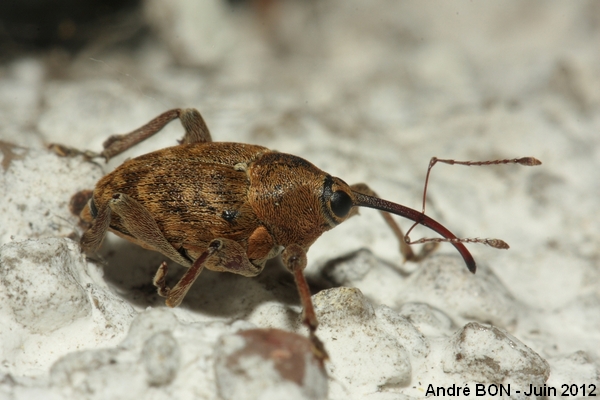
|
The rostrum shorter than the body length and the antennae inserting at half length indicate one male. The last articles of the antennae, clearly knotty, confirm the Nut Weevil species. I have to say that I have a beautiful tuft of Hazelnut Trees in my garden ... |
| [To know more about the Nut Weevil] [Next picture] [Previous picture] [Top] |
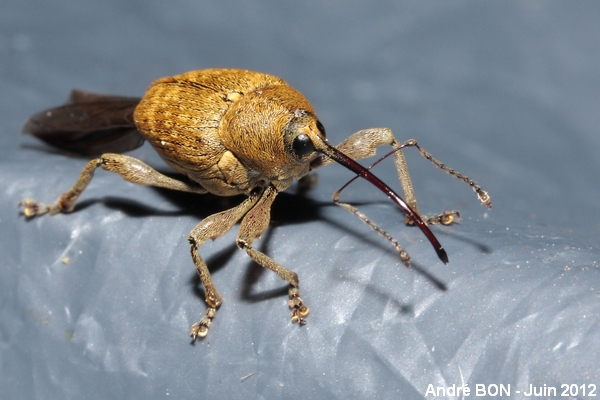
|
I have shot this picture under a Hazelnut Tree. The rostrum being a long as the body and the antennae inserting at the first third indicate one female. You can see the membranous wings at the rear. The Nut Weevil can fly very well. It is no use to try to stop its route along trunks, this is totally ineffective. |
| [To know more about the Nut Weevil] [Next picture] [Previous picture] [Top] |
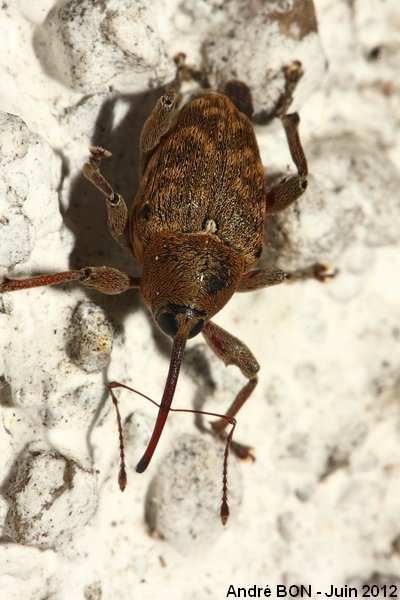
|
Here is an upper side view. You can clearly see the tooth on the fore femur. |
| [To know more about the Nut Weevil] [Next picture] [Previous picture] [Top] |
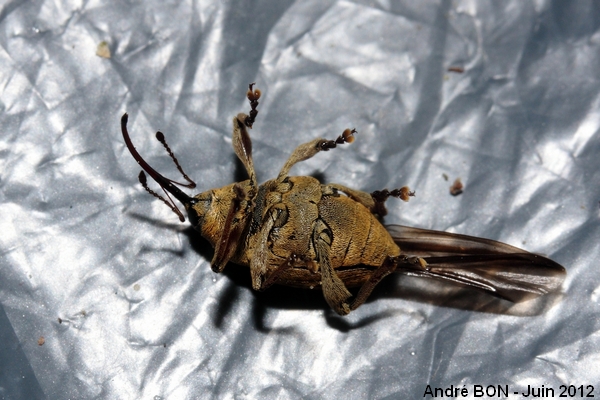
|
The Nut Weevil simulates death when it is threaten as a reaction of defence (reflex of catalepsy). I have used this fact to shoot an underside picture. One or two minutes later it was totally awake and ready to lay its eggs on other nuts. |
| [To know more about the Nut Weevil] [Next picture] [Previous picture] [Top] |
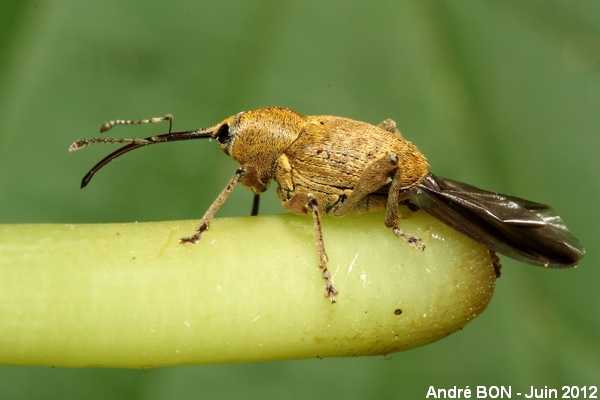
|
Another little exception to my personal ethics. I allowed myself to lift the Nut Weevil upon a stem to place it in front of the camera lenses. |
| [To know more about the Nut Weevil] [Next picture] [Previous picture] [Top] |
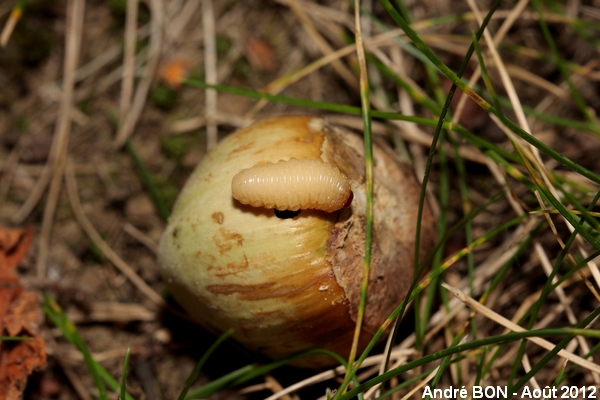
|
Hazelnuts inhabited by a weevil larva usually fall down a little before the others. Looking at fallen hazelnuts, it is rather easy to see larvae coming out and then sink under the ground. Just the time to go and fetch the camera, the larva was outside the hazelnut. It's me who put it back on the hazelnut to shoot the picture. |
| [To know more about the Nut Weevil] [Next picture] [Previous picture] [Top] |
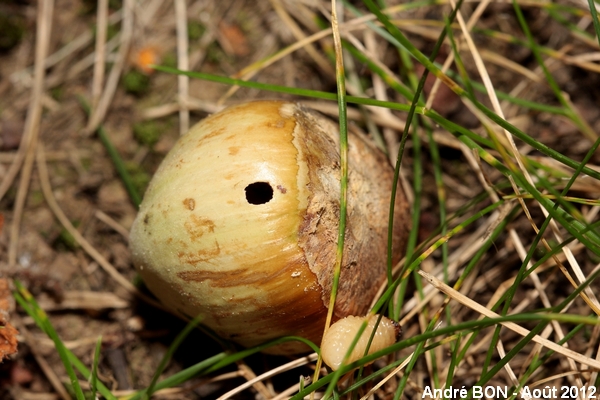
|
This view shows the exit hole drilled by the larva in the hazelnut. |
| [To know more about the Nut Weevil] [Next picture] [Previous picture] [Top] |
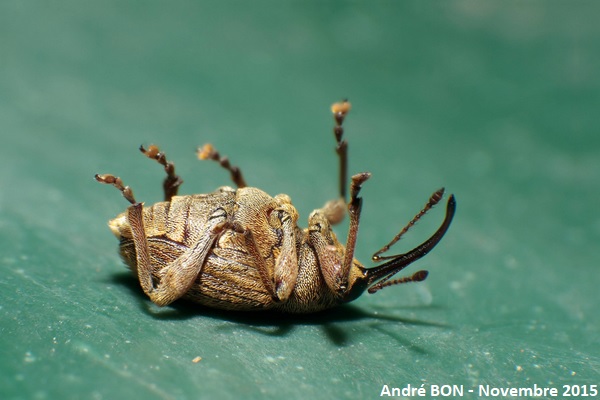
|
Another reflex of catalepsy. |
| [To know more about the Nut Weevil] [Previous picture] [Top] |
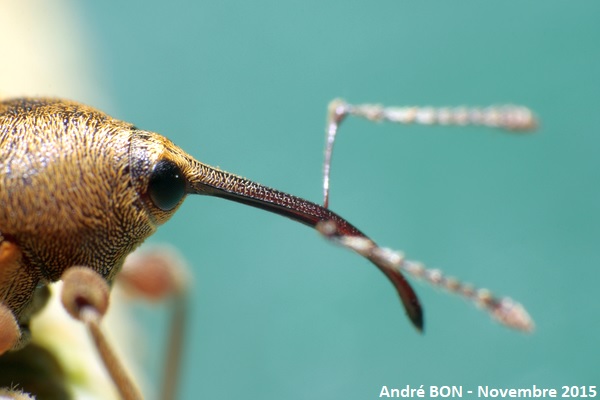
|
Close-up view on this male's rostrum. |